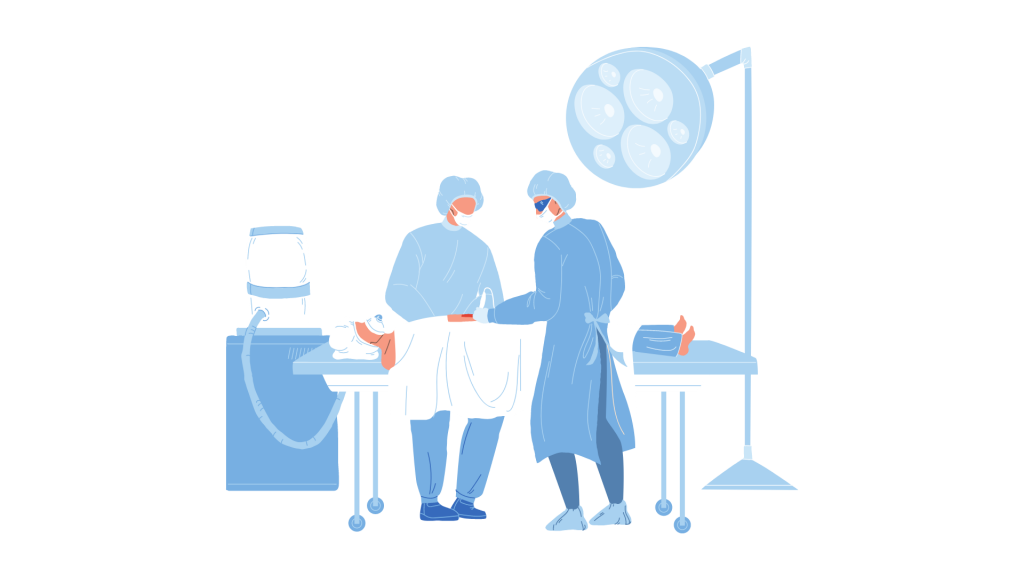Nurses and MSDs in the operating room
We are aware of it today: preventing MSDs is essential for the well-being of employees.
MSDs result from an imbalance between the physical capabilities of the body and the demands and constraints it is exposed to.
In this article, we will focus on O.R. nurses (“State-certified Operating Room Nurses”). An O.R. nurse is responsible for organizing and performing care and activities related to the surgical procedure in the preoperative, intraoperative, and postoperative phases for individuals undergoing surgical, endoscopic, and other invasive technical procedures for diagnostic and/or therapeutic purposes. The O.R. nurse must also implement hygiene and safety measures, considering the risks inherent to the nature of the procedures, the specific characteristics of the patients, working in a protected zone, and the use of specific medical devices.
We met with Aline, 35 years old, who graduated as a nurse in 2011 and has worked as an operating room nurse. Today, Aline is studying to become a state-certified operating room nurse (IBODE in french).
We wanted to meet her to gain a deeper understanding of the constraints of this profession, the realities of the field, and the physical risks of MSDs associated with it.

Special Testimonial : Meeting with an Operating Room Nurse
What is your professional background?
“I graduated as a nurse in 2011 from the “Assistance Publique des Hôpitaux” de Paris. I then worked for a year and a half in the internal medicine department – the department following the Emergency Room. After that, I changed departments and applied for a position as an operating room nurse that did not require prior experience. I worked in an operating room for 10 years before starting my studies to become a state-certified operating room nurse (IBODE), which I will complete in June 2024.”
NB: We differentiate between “operating room nurse” (not IBODE certified) and “state-certified operating room nurse” (IBODE certified).
Is the concept of MSDs addressed internally in the hospital environment, and how ?
“In the initial nursing training, yes. We received information on best practices. For example, how to move a patient from a bed to a chair transfer, being careful about both the patient and we as professionals.
There are topics discussed in terms of MSDs, but from a training perspective, I received a very general introduction. It is not specific to the environment in which you work.
For example, during an operation in the operating room, we need to manipulate the patient as needed (e.g., to turn them), and we do not have training at that level. We help each other and try to be mindful of one another. The IBODE training also does not offer this kind of initiation into the physical risks of MSDs.
We use our knowledge as nurses to best prevent our potential risks.“
What are the main risk factors for MSDs for operating room nurses, and how can they prevent them ?
“Unfortunately, our working environment is challenging. For example, in the operating room, I initially experienced a lot of muscle tension in my shoulders because it is very cold in the operating room.
For hygiene reasons, our attire consists of a short-sleeved gown and pants (along with a cap for our hair, a hood, and a mask). There are also airflows in the operating rooms according to hygiene rules, and the temperature is around 18°C (sometimes less depending on the procedure). We are often static during operations, which increases the physical risks of MSDs. We experience significant temperature variations due to moving between different rooms.
There is also the potential for dehydration because we do not always find time for ourselves; we are focused on our patients.
Additionally, we face physical constraints with patient transfers; patients in operating rooms are anesthetized and therefore non-autonomous. The overweight of a patient can also add difficulty during their handling. We are fortunate to have many staff where I work, which greatly facilitates the handling of the work, for example. But this is not the case everywhere.
There is also the burden of carrying heavy equipment. For example, surgical instruments are gathered in what we call a “composition,” which contains the instruments needed for a specific procedure. But sometimes, especially for osteoarticular surgery, these compositions can weigh up to 16 kg.“
Have you been made aware of the risks of MSDs within your team? What do you think of the measures implemented (in general) to combat MSDs ?
“As far as we are concerned, we have warm-up sheets in the locker rooms, for example. Unfortunately, we don’t always have the time to practice them.
Regarding the cold in the operating rooms, we have jackets available, but they are quite cumbersome and hinder our movements. Perhaps something could be implemented to address this issue.
There is work to be done in terms of raising awareness among supervisors. It would be beneficial to implement an information and awareness program for our ‘team leaders’ so that they, in turn, can train and inform us.
It would also be helpful to have reminders during team meetings to convey important messages. As for printed information, unfortunately, there is a lot of it posted, and we no longer pay attention to it.“
Over the years, have you noticed that MSDs have become a more prevalent topic ?
“Not really, no. We talk about it among ourselves depending on who is already aware—especially colleagues who have experienced work-related accidents.
The biggest constraint in an operating room is the cold.
It is important to highlight that MSDs are multifactorial. They can be related to physical risks but also to hydration or nutritional aspects. In our work rhythm, we don’t necessarily eat regularly, and the same goes for hydration.“
Can you share concrete examples of MSD cases among operating room nurses you have encountered in your practice, as well as the lessons learned, and measures taken to address them?
“Yes. I had a three-week work stoppage due to shoulder pain. I was preparing equipment for the next day’s surgical intervention, and the load was heavy with a side movement; it normally should not exceed 10 kg, but in this case, the load was over 15 kg. Suddenly, I felt pain in my shoulder during the rotation, and it turned out to be a severe muscle contracture related to this incident.
Following this episode, measures were taken to address the equipment load.
However, it might be worthwhile to consider creating specific training for patient transfers and lifting loads—specifically for professionals working in the operating room.“
Conclusion
First, we would like to thank Aline for taking the time to answer our questions and share her experience.
During our discussion, we observed that the lack of awareness among teams can play a significant role in the risks of MSDs, whatever they may be. Regarding the physical risks of MSDs, they are correlated with the work environment: cold, static positions, heavy loads, temperature changes, and the physical handling of patients.
Some facilities lack the resources to optimize the implementation of actions related to the prevention of MSD risks—especially physical ones. Awareness training for teams can be considered as an initial step to mitigate these risks in the hospital environment, particularly in the operating room.
